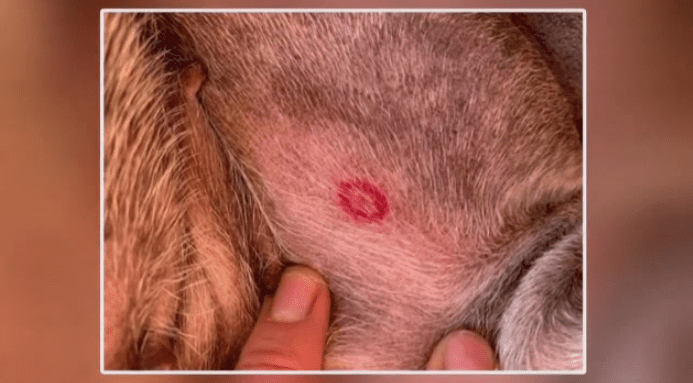Key Takeaways:
- Tick paralysis is a condition caused by toxins released by certain species of ticks, which can affect dogs.
- The symptoms of tick paralysis in dogs include weakness, difficulty walking, and even paralysis.
- Early detection and removal of ticks is crucial in preventing tick paralysis in dogs.
- Treatment for tick paralysis involves removing the ticks and providing supportive care to the affected dog.
- Tick prevention measures such as regular tick checks and using tick preventatives can help reduce the risk of tick paralysis in dogs.
Attention all dog lovers! Have you ever noticed your furry friend acting strangely, perhaps experiencing weakness or even paralysis? If so, then understanding the topic of tick paralysis in dogs is absolutely essential for you. Not only will delving into this subject provide you with valuable knowledge to protect your beloved pet, but it may also save their life. Tick paralysis is a condition caused by certain species of ticks that can attach themselves to dogs and release toxins, leading to muscle weakness and potential paralysis. By gaining a deeper understanding of this topic, you will be equipped with the tools necessary to identify and prevent tick paralysis in your canine companion. So, let's embark on this journey together and ensure the well-being of our four-legged friends!
Understanding Tick Paralysis in Dogs
Tick paralysis is a condition that can affect dogs when they are bitten by certain types of ticks. These tiny parasites attach themselves to the dog's skin and feed on their blood. As they feed, they release a toxin into the dog's bloodstream, which can lead to paralysis if not treated promptly.
The symptoms of tick paralysis in dogs can vary, but some common signs to watch for include weakness in the hind legs, difficulty walking or standing, and even complete paralysis of all four legs. In some cases, the paralysis can spread to other parts of the body, including the muscles used for breathing.
How Ticks Can Cause Paralysis in Dogs: Symptoms to Watch For
Ticks are small arachnids that can transmit diseases to animals and humans through their bites. When a tick attaches itself to a dog and begins feeding on its blood, it can also release a neurotoxin into the dog's system. This neurotoxin affects the nerves and muscles, leading to paralysis.
- Weakness in the hind legs
- Difficulty walking or standing
- Paralysis of all four legs
- Difficulty breathing
- Lack of coordination
The Dangers of Tick Paralysis for Dogs: Prevention is Key
Tick paralysis can be a serious condition that poses risks to a dog's health and well-being. If left untreated, it can lead to respiratory failure and even death. That's why it's important for dog owners to take preventive measures to protect their pets from ticks.
To prevent tick paralysis, you should:
- Check your dog for ticks regularly, especially after spending time outdoors
- Use tick prevention products recommended by your veterinarian
- Keep your yard and outdoor areas clean and free of tall grass or brush where ticks may hide
- Avoid walking your dog in areas known to be infested with ticks
- If you find a tick on your dog, remove it carefully using tweezers or a tick removal tool
Are Some Dog Breeds More at Risk for Tick Paralysis?
While any dog can potentially be affected by tick paralysis, certain breeds may be more susceptible to the condition. This is because some dogs have a higher sensitivity to the neurotoxin released by ticks. Breeds that are commonly reported to be more at risk include:
- Labrador Retrievers
- Golden Retrievers
- Australian Shepherds
- English Setters
- Irish Setters
Checking Your Dog for Ticks: A Simple Guide for Owners
To check your dog for ticks, follow these steps:
- Gently run your hands over your dog's body, feeling for any small bumps or lumps.
- If you come across a bump, part the fur to get a closer look.

Treating Tick Paralysis in Dogs: Options and Recovery Time
If you suspect that your dog has tick paralysis, it's important to seek veterinary care immediately. The veterinarian will likely remove any remaining ticks and provide supportive care to help your dog recover.
The recovery time for tick paralysis can vary depending on the severity of the condition and how quickly treatment is administered. In most cases, dogs show improvement within 24-48 hours after tick removal and treatment. However, it may take several days or even weeks for full recovery.
How Ticks Can Cause Paralysis in Dogs: Symptoms to Watch For
Ticks are small parasites that can attach themselves to dogs and feed on their blood. While most tick bites are harmless, some species of ticks can cause paralysis in dogs. Tick paralysis occurs when a female tick releases a neurotoxin into the dog's bloodstream while feeding. This toxin affects the dog's nervous system, leading to muscle weakness and eventually paralysis if left untreated.
Symptoms of tick paralysis in dogs may vary but typically start with a loss of coordination and weakness in the hind legs. As the paralysis progresses, it can spread to the front legs and eventually affect the muscles responsible for breathing. Other signs to watch for include difficulty swallowing, changes in bark or meowing, drooling excessively, and respiratory distress.
If you notice any of these symptoms in your dog, it is crucial to seek veterinary care immediately. Tick paralysis can be life-threatening if not treated promptly. Your veterinarian will conduct a thorough examination and may recommend removing any attached ticks carefully. Treatment options may include medications to counteract the effects of the neurotoxin and supportive care such as intravenous fluids.
The Dangers of Tick Paralysis for Dogs: Prevention is Key
Tick paralysis poses significant dangers to dogs and can even be fatal if not addressed promptly. The paralysis caused by ticks affects a dog's ability to move, eat, drink, and breathe properly. In severe cases, this can lead to respiratory failure and death.
Prevention is key when it comes to protecting your furry friend from tick paralysis. Regularly checking your dog for ticks after outdoor activities is essential. Pay close attention to areas where ticks commonly hide, such as around the ears, between toes, under armpits, and along the belly. Using tick prevention products recommended by your veterinarian can also help reduce the risk of tick bites.
Additionally, keeping your yard well-maintained by regularly mowing the grass and removing any debris can help minimize tick populations. Avoiding areas with high tick infestations, such as tall grasses and wooded areas, can also reduce the chances of your dog encountering ticks.
Are Some Dog Breeds More at Risk for Tick Paralysis?
While any dog can potentially develop tick paralysis, certain breeds may be more susceptible to this condition. Breeds with longer hair or thick coats, such as Golden Retrievers, Labradors, and Collies, are often at higher risk due to the difficulty in detecting ticks hidden within their fur. Dogs that spend a lot of time outdoors in tick-infested areas are also more likely to be exposed to ticks and develop paralysis.
It is important for all dog owners to be vigilant in checking their pets for ticks regularly, regardless of breed. However, if you own a breed that is known to be more prone to tick paralysis, taking extra precautions becomes even more crucial. Regular grooming sessions where you thoroughly inspect your dog's coat for ticks can help identify and remove them before they have a chance to cause paralysis.
Checking Your Dog for Ticks: A Simple Guide for Owners
Checking your dog for ticks should become a routine part of your pet care regimen. Here is a simple guide on how to check your dog for ticks:
1. Start by running your hands over your dog's body, feeling for any unusual bumps or lumps.
2. Pay close attention to areas where ticks commonly hide, such as around the ears, between toes, under armpits, and along the belly.
3. Part your dog's fur gently and visually inspect the skin for any signs of ticks.
4. If you spot a tick attached to your dog's skin, use tweezers or a tick removal tool to grasp it as close to the skin as possible.
5. Slowly and steadily pull the tick straight out, making sure to remove the entire tick, including its mouthparts.
6. Clean the area with an antiseptic solution to prevent infection.
Remember to check your dog for ticks after outdoor activities, especially in areas known to have a high tick population. Early detection and removal of ticks can help prevent tick paralysis and other tick-borne diseases.
Treating Tick Paralysis in Dogs: Options and Recovery Time
When it comes to treating tick paralysis in dogs, prompt veterinary care is essential. The first step is usually removing any attached ticks carefully. Your veterinarian may recommend using tweezers or a tick removal tool to grasp the tick as close to the skin as possible and gently pulling it out.
In severe cases of tick paralysis, your dog may require hospitalization for supportive care. This can include intravenous fluids to maintain hydration, medications to counteract the effects of the neurotoxin, and monitoring of vital signs.
The recovery time for dogs with tick paralysis varies depending on the severity of the condition and how quickly treatment was initiated. Some dogs may show improvement within a few hours or days after tick removal and treatment, while others may take several weeks to fully recover. It is important to follow your veterinarian's instructions regarding medication administration, follow-up appointments, and any necessary lifestyle changes during the recovery period.
By being proactive in preventing tick bites through regular checks, using preventive products recommended by your veterinarian, and seeking immediate veterinary care if you suspect tick paralysis, you can help ensure your dog's well-being and minimize the risks associated with this condition.
In conclusion, tick paralysis is a serious condition that can affect dogs when they are bitten by certain ticks. It causes weakness and can even be life-threatening if not treated promptly. It is important for dog owners to check their pets regularly for ticks and seek veterinary help if any symptoms arise.
Can a dog recover from tick paralysis?
With proper treatment, the majority of dogs will be able to recover from tick paralysis. However, the cost of treatment can be quite expensive, reaching thousands of dollars, and unfortunately, some dogs may still pass away even with the best care from veterinarians.
What is the survival rate of a dog with a tick paralysis?
The survival rate for tick paralysis is 95% if it is detected early and without any complications. If the dog's condition worsens to the point where ventilator support is needed, the survival rate drops to 50%. If you discover a tick on your dog, remove it and save it in a container for your veterinarian to identify.
How do you get rid of paralysis ticks on dogs?
Gently separate your dog's fur and securely hold the tick as close to the skin as you can, being careful not to pinch the skin. Twist the tick either clockwise or counterclockwise and carefully pull it away from the animal's skin. After removing the tick, examine the area to make sure that the head and mouthparts have been successfully removed.
How long does paralysis tick toxin last?
After tick paralysis, your pet's body will continue to be affected by the tick toxin for a period of 6-8 weeks, although it may be more difficult to notice.
Can tick paralysis cause permanent damage?
The majority of patients experiencing tick paralysis will make a complete recovery with appropriate care and the removal of the tick. However, if left untreated or misdiagnosed, the mortality rate for tick paralysis can be as high as 12%.
How much does paralysis tick treatment cost?
The cost of treatment for an uncomplicated patient can range between $900 and $1800, depending on the size of your pet. For complicated tick paralysis treatment, the cost can be twice as much.

















